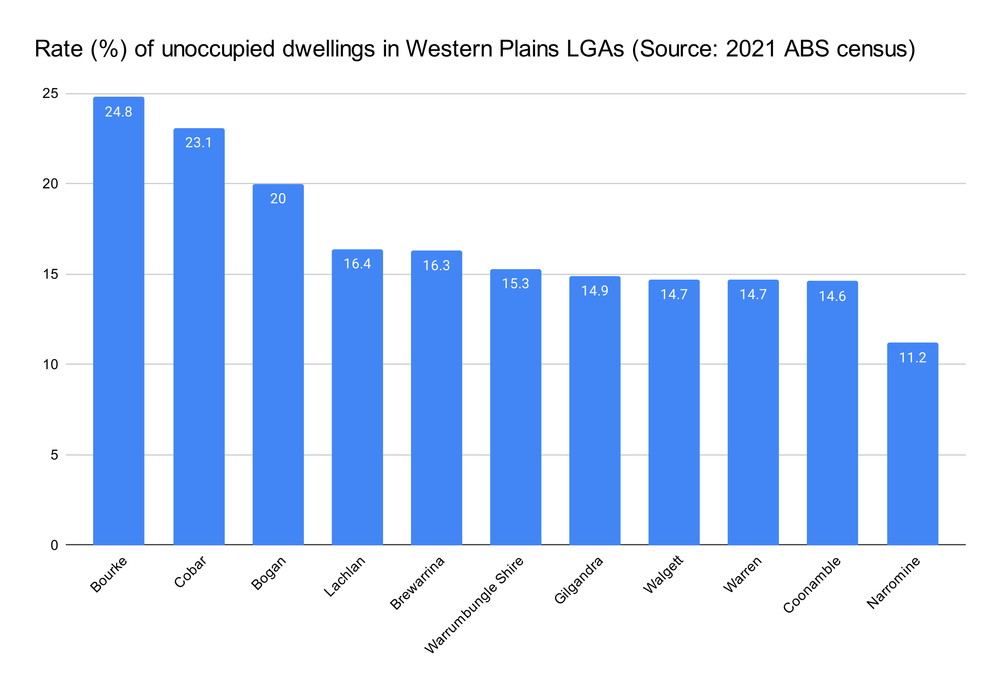How to count Orana's empty houses?
River McCrossen
29 April 2024, 9:20 PM
 A house in Coonamble gutted in a fire on 20 April 2024. PHOTO: River McCrossen
A house in Coonamble gutted in a fire on 20 April 2024. PHOTO: River McCrossenThe NSW minister responsible for housing says it’s unclear exactly how many dwellings are unoccupied in the Orana region.
Knowing how many houses are dilapidated and unoccupied, and who owns them, can help identify potential development opportunities to lift housing supply in the Western Plains.
In March 2024, the residential vacancy rate sat at zero per cent in postcodes Bourke and Walgett, 1.1 per cent in Coonamble, 0.5 per cent in Gilgandra, 0.9 per cent in Cobar and 0.6 per cent in Warren, according to SMQ Research.
NSW Minister for housing Rose Jackson said the government doesn’t have a precise breakdown for public-private ownership of unoccupied dwellings in the Orana.
“For government-owned homes, obviously we do map that very closely. If we own it, we know if someone’s living in it, if someone’s moved out, what condition it’s in,” Ms Jackson said.
“I have some sense in your region about NSW government-owned homes and where they are unoccupied, but in the Orana region, no, we don’t have that level of data.
“We’re relying on our partners in local government, we’re relying on the census, we’re relying on the bit of data that we do have, whether it’s land tax information, whether it’s short term rental registers. It’s not a complete picture, but I hope that people can understand, when you got a state the size of NSW with the millions, and millions and millions of dwellings that we would have, getting that kind of granular detail is challenging.
“We’ve got some work we can do using land tax, because that maps people’s property holdings and excludes the primary place of residence, so it’s a way to try and get a picture, but that doesn’t really show if they’re tenanted or not. So, for us to do it state-wide in the private housing market is very hard.
“But local councils, particularly in regional areas, can do a lot to try and map their local area and we’re happy and keen to support them to do that.”

The 2021 census revealed Bourke and Cobar LGA had some of the highest unoccupied dwelling rates in the state.
Bourke was at 24.8 per cent with 579 empty houses. Cobar was at 23.1 per cent with 533.
In comparison, Narromine sat at 11.2 per cent with 2550 empty houses.
However, Coonamble Shire General Manager, Paul Gallagher, said the census numbers are distorted in his LGA.
"There are other properties owned by rural property owners who use the house during wet weather periods to allow for children to attend school etc. These houses have distorted the census to some degree as they present as a vacant house,” Mr Gallagher said.
Ms Jackson also said the census rate is “the best thumbnail sketch we’ve got, but it’s not very detailed.”
“The census isn’t necessarily great because what if someone’s just away on holiday for two weeks?” Ms Jackson said.
“Is it under renovation? Is the owner just living somewhere else for a short period of time? Has the home been abandoned? Is it empty because it’s up for sale?
“That level of detail is hard for us to grapple with.”
Ms Jackson said the state-government is revamping it’s own dilapidated housing as a priority under it’s strategy to increase supply.
“I know for example in Coonamble there are a couple, I think two or three, vacant homes that the NSW government owns.”
“Some of them are in a state of disrepair, so we are going to go and try and make sure that they’re turned around.”
Ms Jackson said the government can also reach out to private owners.
“Stuff that’s worked quite well is identify who owns the home and directly getting in touch with them and saying ‘what’s your plan?’” Ms Jackson said.
“It doesn’t always work, but often it yields good results. People would say ‘oh, fair enough, you know what? I’ll sell it.
“That’s where I think that partnership with local government is really valuable.”



